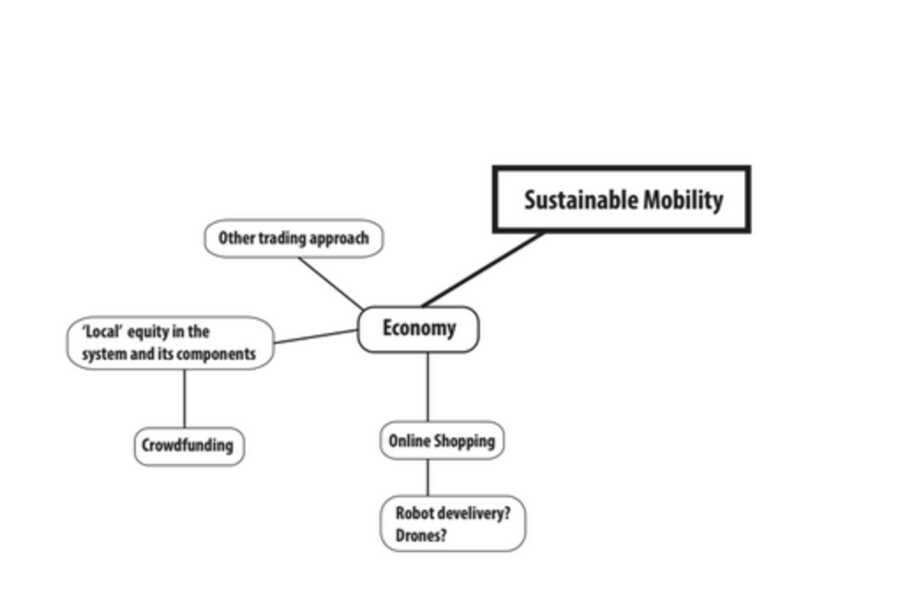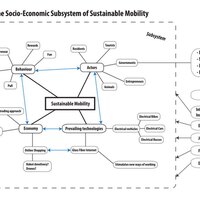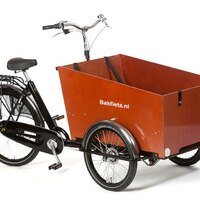3.1 Four mobility concepts
The mobility concepts are clustered in four modes of mobility. The first two modes are the private and the public mode. Both these modes describe the transportation of people in their daily life. The difference between these modes is that in the private mode people use ways of transportation that are their (temporary) property like their own cars and bikes but also rental vehicles. The public mode describes ways of transportation that are publicly available, and that is shared with other people. Please note that for some initiatives the barrier between these modes will be low. For instance, a rental bike may be publicly available, but a rental bike is still considered a private mode since it does not have fixed routes, timetables or is shared with other people.
The third mode is the transportation of personal goods, in this case defined as transportation from the physical or digital shops to the houses of the consumers. The fourth mode describes a tourist attraction initiative that could enhance the mobility while showing tourists some sustainable initiatives on the island.
3.1.1 Private transport
Carpooling
Table 2.1.1 shows that 6619 passenger cars are owned by Texelaars. Figure 2.1.1 shows over 3000 cars pass the road to the Ferry during low season. Unfortunately this count does not list how many of those cars are tourists and how many of those are Texelaars travelling to the mainland but even if only a quarter of those cars are commuters that would be over 750 cars on a daily basis. A good starting point towards a more sustainable Texel would be to try to reduce this amount of vehicles. An initiative that could easily be implemented with low cost is carpooling to and from the ferry. Carpooling is sharing your car with another person that needs to travel in (approximately) the same direction. This therefore decreases the amount of cars on the road. Although Texel is a small community, it might be that someone from De Koog doesn’t know that another person from Den Burg works in the same neighbourhood. A website or an app could help to bring these people together. This app could also function as a sort of mediator between both parties that keeps track of costs. Once on the mainland, people can continue carpooling or transfer to their own vehicle which is parked in Den Helder. Another possibility is using rental cars on the mainland which is discussed in the following section.
Greenwheel style Rental
Carpooling could be combined with a greenwheel styled rental service. Greenwheels is a company that offers subscribers the possibility to frequently rent a car at relative low costs. People reserve a car via the website or by using a app. Cars are placed all over the Netherlands because people can find them where the last person who rented it left it. A comparable service could be a solution for Texelaars who carpool towards the mainland and then transfer to a rental car that can take them to their destination. These rental cars could of course also be placed on Texel. Both Texelaars and tourists could use these cars, which will of course be sustainable electric vehicles. These vehicles will be used exclusively on the island and since travelling distances on the island are small, they can be fitted with smaller battery packs. This would reduce the weight and therefore the energy consumption of the car as well as the purchase price. A possible downside of this project is the large amount of initial investment in the purchasing price of the vehicles and the adaptation of the infrastructure (installing charging poles). Crowdfunding combined with a partnership with a car manufacturer could be possibilities to finance this project. Like with the TESO company, Texelaars could also be asked to invest in this project for which they get shares in return. This immediately also involves the Texelaars in the project and they will have an incentive to promote the use of these cars to tourists. Tourists can use the service to get around on the island, when they aren’t using bikes.
Bike system
A decision to take the car instead of the bike can sometimes be due to the fact that goods need to be transported, for instance grocery bags from the store. To solve this problem while promoting biking as a mode for transport, a number of “bakfietsen” (see figure 1) will be present on the island for rent. The bikes can be stationed to certain spots on the island where people who are in need of a bike can rent one and return it to whichever other station. The stations should preferably be located close to shops. The fee for renting a bike will be small, just to cover the maintenance. By using the same payment system/fare system as with the buses, it will be easy to use the bakfietsen in combination with the buses, and the use of cars can be avoided as far as possible. It is an option that stores on the island, such a grocery stores, could sponsor this service and in return get rental locations close to their shop and space for ads or other commercial messages on the bakfietsen.
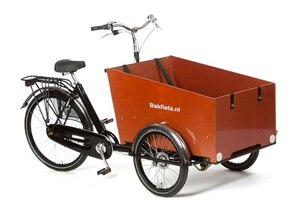
Figure 3.1.1. An example of a "bakfietsen". Source: (Bakfietsen)
3.1.2 Public transport
Bus system
Public modes of transport should be present to the island to offer everybody the possibility to transport themselves in a sustainable way on Texel. The service needs to be affordable to ensure that inhabitants with differing situations can travel in a environment friendly way. Currently, a bus service is present on the island. This can be used both by local residents and tourists. Since tourists and local inhabitants may have somewhat different needs (which has been explained in previous chapters), public transport has a tough role of satisfying everyones needs. How can that be done? The initiatives taken by Texelhopper to provide a service that merges the functions of a taxi and a bus is in a good direction (Texelhopper). Texel is not a very big island, and therefore it might not be feasible to drive normal sized bus in a periodic timetable. The risk is that the bus will run empty in some directions/times of the day/times of the year, and that the municipality will lose a substantial amount of money. However, suggesting a fleet of minibuses that does not run on a periodic timetable but rather in a “dial-a-ride” manner, could ensure that no buses (or at least fewer) run empty. The benefits of sharing a ride are congestion relief, noise reduction, emission deduction, etc. For elderly people who live alone it can also be a way of socializing. The service would need to be booked in advance, which is a drawback when unsuspected things happen, but then other alternatives for transport are available (bikes, rental cars etc.). The minibuses would be powered by a hybrid engine of biofuel and electricity, and the fare would not be higher than it is currently for a bus ride. The buses will also be fitted with a bike rack so that multi-modality in that way is promoted.
When large groups of tourists arrive on the island, an idea is for the municipality of Texel to own tourist coaches that are propelled by renewable energy sources (such as biofuels, electricity) that can be used in high-peak seasons to transport tourists from the ferry connection to their first destination on the island.
3.1.3 Transport of personal goods with driverless vehicles
For the near future, stretching from 2015 up to 2030, plans and regulations will have to be made for driverless and other types of automated vehicles. These vehicles will enable light weight direct on-demand cargo, increasing its efficiency and thus the sustainability of the field. It is not to be ruled out that in the coming years several big enterprises will already start deploying driverless vehicles for package delivery, especially in the more rural areas where land infrastructure is missing (Frey, 2011).
At this moment almost all cargo arrives at Texel by ferry. This could change in the future, where Den Helder could be a good spot for a automated vehicle base to supply Texel and maybe even Vlieland quickly with goods. In the beginning, these will be mostly emergency goods, related to health care such as medicines and medical equipment. Basically things that are light weight, but high of value (Allison, 2013). When automated technology continues to develop and becomes cheaper, also heavier cargo could be taken from the mainland to Texel. Texel definitely needs to be prepared for robotization, which will start on the mainland where goods will arrive by autonomous drone trucks, from where they will go on the ferry or be taken over by automated vehicles that transport them to Texel on water or in air. The main advantage of this robotization are the reduced costs (Dronelife News, 2014).
A nucleus for this activity on Texel could be the existing airstrip, although location-wise it would be better if it is closer located to Den Burg, the capital of the island. The municipality of Texel should decide if they want a central pick-up place for cargo, or if they want these vehicles to have freedom to move everywhere in the Texel airspace. In that case, at-home delivery services can flourish.
Something important to take into consideration is the legal structure for these vehicles. Texel will definitely need to invest time and money in clarification of the legal boundaries for these new ways of transport.
3.1.4 Tourist attraction
A suggestion for making the island as interesting as possible from a tourist point of view is to add a way of transport that is also functions as a tourist attraction. This could be part of some sort of sustainability tour across the island. One example could be a cableway. Usually cableways are utilised in hilly environments, such as ski resorts. However, it is a wonderful way of experiencing an environment from up high. The cableway on Texel would have stops at important tourist attractions around the island, making it possible to get out of the cable car and discover. The cableway would be used in a recreational purpose and give tourists a spectacular memory of Texel. Monorails are also a possible alternative. These can be placed on the surface level, which will decrease landscape pollution, or elevated on viaducts, which will improve the view.
The main concerns for these ways of transport are costs and landscape pollution. Installing such a system on the island will take multiple years of construction and it will undoubtedly have it’s impact on the the landscape. Since landscape pollution is one of the major objections against windmills for renewable energy, this idea might be dead from the start. A surface level monorail would decrease this effect, but does that really have a great benefit over a car or better a bike? There are many different options to chose from in this mode and further research needs to be conducted on what option is suited best for Texel.
3.2 Who are the actors?
This section uses the actors as listed in section 2.1. It will not only look at their roles, but also provide a peek into the new socio-technical landscape. Please note that some actors with comparable roles are grouped.
Inhabitants
Inhabitants are mainly users of the sub-system. We wish that the Texelaars will be very open for the new initiatives and cooperate smoothly. Texelaars are proud of their island and are, according to what Han Brezet told in the first lecture, unfortunately not very cooperative with forced transitions from the mainland. An actual implementation of our plans could try to minimise this resistance by combining the plans with local initiatives and local entrepreneurs. The most important thing however is to listen to the concerns the Texelaars have and to try to incorporate these concerns in the design.
Tourists
Tourists are users of the sub-system. Frequent visitors of the island will have to adapt in the same way that inhabitants do. It is therefore important to take their concerns into account as well while designing the sub-system.
Public transport providers
The public transport providers are the main actors in the implementation of the new bus system. A close cooperation with the municipality is required to make sure that the new service fulfills the needs of the users. Monitoring is therefore another important task of these public transport providers.
Private transport providers
These companies now offer coach and taxi transport services. This research has no clear solution to replace these vehicles with more sustainable alternatives. These are private owned companies. It is our vision that these kind of companies are inspired by other initiatives on the island and will move along with the sustainability trend.
TESO
TESO is already investing heavily to make the ferry service more sustainable. In the years to come they will have to continue these activities.
Rental companies and general mobility service and maintenance companies on the island
These companies play a major role in our plans of introducing a greenwheel styled rental service or expand the (electric) bike rental alternatives. Since these are also privately owned companies, intervention from a third party like the municipality or NGO will be needed to create plan that works on the entire island with different companies.
Businesses in the tourism/hospitality industry and general local businesses
These companies are users of the system but also need to adapt to the changing mobility of their customers. As was already mentioned in section 2.1, an increasing amount of electric vehicles for instance calls for more charging possibilities on the premises of these companies. Some companies may have car parks that they want to replace in order to fit in the sustainable mobility system. Just as with the private transport companies it is our vision that these kind of companies are inspired by other initiatives on the island and will move along with the sustainability trend.
Governmental bodies
To accommodate the transition into a sustainable mobility system, the local governmental bodies need to take on a mediating role. It is their task to combine different parties within different initiatives and to monitor the development of these initiatives. Financial support could either come from the municipality budget or by assisting and mediating with higher governmental bodies. These higher governmental bodies mainly play a financial role in the local mobility transition.
Non Governmental Organisations (NGO’s)
As mentioned in section 2.1, these organisations all have their own interests. Some parties will be involved in almost every initiative (ANWB, Duurzaam Texel, SIGT, TOP, Urgenda, Veilig Verkeer Nederland), others only in very specific plans like for instance Rover in the busses plan or the VVV in the touristic attraction initiative.
Suppliers of technology
We now have a more clear vision of suppliers that play a role. The greenwheel style rental initiative requires a large amount of new electric vehicles. This requires supplies from car manufacturers, but also charging stations and spare parts. The same goes for the (electric) bikes and busses. Supplies of drones might still be a little further in the future. The tourist attraction requires some large construction works and requires a unique design and specialised contractors.
3.3 How will the technologies be embedded in culture and behaviour in the future system?
In the new subsystem, people will go about as they always have; working, going to school, sightseeing, etc. However, in this new mobility system their actions will have far smaller negative impacts on the environment. Not to mention, the local economy on the island will prosper from this new system, as transportation is a key ingredient for tourism (Currie & Falconer, 2014). People want transportation to work, without too much effort or expenses. Some people have an interest in cars or other types of transportation as a hobby, but the everyday mobility should be easy to use. Local residents and tourists should not need a certain kind of knowledge to transport themselves, other than what can be required in other places (e. g. drivers license, be able to read a timetable, etc.). Since the new mobility system is to be used by everyone, not just educated people or people with a special interest in mobility, it needs to be innovative without being complicated. It should be so effortless to transport oneself in a sustainable way that no additional thought or action is required.
Previous chapters have mentioned the special culture on Texel, the “Island identity”. The heritage is important for people on Texel, and their local community is strong (see chapter 4). Identity is in Stets and Biga’s (2003) article defined as “[…] a set of meanings attached to the self that serves as a standard or reference that guides behavior in situations.” The hope is that the island identity of Texel in the future can include mobility, for example “I am a Texelaar, and I bike” or “I’m a Texelaar and I don’t use non-renewable fuel”. An intention with this new mobility system is to try to include the way of thinking about transportation in the identity of Texelaars. This is not done in a heartbeat, but will hopefully grow stronger year by year with younger generations. Tourists can then be inspired by “the Texelaar mobility” and experience it for themselves.
3.4 Economy
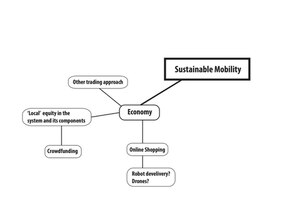
Figure 3.4.1. The economy in the subsystem of sustainable mobility can be approached in different ways.
3.4.1 What is this economy?
First of all, what is an economy. According to the Business Dictionary (2014), an economy is an entire network of producers, distributors, and consumers of goods and services in a local, regional, or national community (Source: business insider)
The two biggest groups of consumers in this subsystem are the residents and the tourists. Furthermore there is transportation that contibutes to the subsystem of sustainable mobility. The distributors of this economy isthe municipality of Texel. The producers of this system are TESO, which provides the ferry connection to Den Helder and the municipality, which constructs and maintains the infrastructure. Since residents of Texel can have a share in TESO, some users are at the same time producers.
3.4.2 What influences this local economy?
The economy of sustainable mobility is heavily influenced by the amount of users. The more users, the more services will have to be produced (e.g. the ferry connection) and the more maintenance the infrastructure requires. The amount of users depends on three things:
- The amount of residents
- The amount of tourists
- The amount of transportation
Future transportation over water and road can be reduced due to the emergence of driverless vehicles and 3D printing technologies. The amount of residents is projected to stay equal the coming 10 to 15 years (Afdeling Samenleving gemeente Texel, 2007). The population pyramid will shift though, with a bigger group of elderly representing the future Texel population around the year 2025. The mobility has to be adjusted to the needs of this group. It is expected though that technological developments will continue evolving rapdily, offering solutions for this group to remain mobile. One of these developments that already impacts the current mobility in the Netherlands, is the emergence of electrical bikes. These bikes support the cyclist by low speeds and enable the cyclist to reach higher speeds with less physical input required than conventional bikes.
Tourism is expected to stay equal to current numbers, around 800.000 visitors. On Texel it is agreed that not more than 45.000 beds can be used at the same time. This number has never been surpassed and it is expected that this will never happen in the future as well.
3.4.3 What kind of new economic models can emerge in our subsystem?
For the future of the susbsytem of sustainable mobility, there are many possible direction for Texel. If Texel wants to keep the proper infrastructure in tact with a good flow of traffic, but at hte same time wants to become more sustainable, the following options could be employed:
- An island free of cars working on fossil fuel combustion engines. The municipality of Texel can decree to ban all fossil fuel driven cars by the year 2020. A softer method with similar effects would be to tax owners of fossil fuel driven cars, or alleviate taxation for households in possession of electric cars, (eletric bikes) or hydrogen fueled cars. Tourists can come with fossil their fossil fuel driven cars, but they will have to buy a special vignet, just like the autobahn-vignet in Switzerland, valid for a certain period. Tourists can also opt to leave their car in Den Helder and make use of electric transport on theisland.
- Texel could also move towards a lease and share economy, where the residents and tourists are stimulated to lease instead of owning. Transport can then be leased from other households nearby for an agreed tarif, or from an overarching organization that the municipality of Texel will have to establish in collaboration with its residents. The transport that will be provided by this ‘foundation’ will have to be electrical.
- For the development and maintenance of the infrastructure, new ways of financing can be used such as crowdfunding. People on the island can adopt a certain part of the road and its associated elements such as lighting. They are then responsible for the maintenance of this part of the infrastructure. Another idea is that through crowdfunding new infrastructure is developed and old infrastructure is maintained, whereby the phrase ‘who pays, decides’, defefintely accounts. This means that the ones investing in the infrastructure and the mobility, can also decide about the visual reprensetation of this infrastructure, the materialization and so on.
Important for all these ideas, is that they work best when all deployed. A ‘ban’ on fossiel fuels works best if there is also a proper alternative provided, since it will otherwise only result in an unsatisfied population. A lot of responsibilities will therefore be assigned to the municipality of Texel, which will have to coordinate this transition in mobility and infrastructure. They will have to plan recharge points for electrical transport throughout the island, they will have to make a plan for a proper air control system with regards to the emergence of drones and they will probably have invest in the infrastructure for hydrogen stations. Furthermore, the island can only become sustainable if the electricity at the recharge points comes from clean sources, such as solar energy, wind energy or other clean energy sources. Planning, coordination and investment in these areas is thus vital.
3.4.4 What kind of societal developments can lead to trend shifts in our subsystem?
There are four important development that will influence the mobility and infrastructure on Texel a lot.
- The shifting of the groups within the population pyramid of the Texel residents, as well as the shift in the age pyramid of tourists. Due to the aging of both groups, certain interventions need to be done in the Texel infrastructure. A focus on safe electric bikes would be a good direction, since this way of transport provides a pleasant and safe way to explore the island for these tourists and it enables older people in less physical condition to still fully participate.
- Texel is a small island. This makes it very suistable for electrical transport, since the main contra argument for electrical transport is its low driving range. Electrical cars are cleaner, but also make a lot less noise. The entire Western part of Texel is national park and Texel is famous for its variety of birds on the island. These animals will probably benefit from a cleaner and more silent environment. When the generation of energy is also transitioned to cleaner sources such as wind energy and solar energy, the mobility sector of Texel could become self-sufficient in the long term.
- Transportation in the near future will happen by drones (unmanned vehicles). These drones will either fly from the main land to Texel, or they will be deployed as unmanned boats, unmanned driving vehicles and so on. This needs regulation and everyone, the residents and the tourists, will have to get used to the idea of having participants in traffic which are robot-controlled instead of human.
- As said before, due to the emergence of the lease and share economy, the need to own things will slowly evanish. This will make the mobility and transportation system of Texel way more efficient, as it requires less transportation items (such as cars, bikes and so on) on the island, to accomodate the needs of the residents and the tourists.
3.5 How will the elements in the future sub-system be interrelated?
The prevailing technologies in the subsystem are one of the most important things. With prevailing technologies such as glass fiber internet, taking a very important place. The development of glass fiber internet can enable the Texelaars to work more out of their own home, this way the physical infrastructure of the island will be used less frequently.
3.6 By which rules and regulations will the future sub-system be organized?
The different governmental bodies that influence the policy on Texel are in order of importance, the EU, the national government, the provincial government and the local municipality of Texel. There are different tools governments can use in order to achieve the desired result, such as information and communication tools, economic tools, juridical tools, facilitating intruments and enforcement instruments. Economic tools that could be used to stimulate the residents and tourists of Texel to make more sustainable choices are for example incentives in the form of tax reliefs, financial penalties or subsidies. Communication and information tools could be special events organized by the local government in order to inform and persuade the local population about the importance of sustainable development, the diffusion of information folders, a good working website and so on. Juridical instruments are for example prohibtions, permissions, or decreets. An example could be the prohibition of fossil fuel driven vehicles on the island. Faciliating instruments can be for example proper development and maintenance of the infrastructure and the mobility on the island. Last but not least, enforcement instruments could be used if people are not complying with the rules and regulations, but this is defenitely not the preferable option.
References
Afdeling Samenleving gemeente Texel. (2007). Demografische ontwikkelingen Texel. Texel.
Allison, G. (2013). Forget roads – drones are the future of goods transport. New Scientist.
Bakfietsen. Models. Collected from Bakfiets: http://bakfiets.nl/eng/modellen/cargotrike/large/ the 20th of December 2014
Berman, B. (2011). 3-D printing: The new industrial revolution. Hempstead, NY, Frank G. Zarb School of Business, Hofstra University.
Business Dictioniary. "Economy Definition." fromhttp://www.businessdictionary.com/definition/economy.html.
Currie, C., & Falconer, P. (2014). Maintaining sustainable island destinations in Scotland: The role of the transport–tourism relationship. Journal of Destination Marketing & Management , 3, pp. 162–172.
Dronelife News. (2014). " 5 Reasons Drones Will Change the Future of Cargo." fromhttp://dronelife.com/2014/08/11/5-reasons-drones-will-change-future-cargo/.
Frey, T. (2011). "2050 and the Future of Transportation." collected from http://www.davinciinstitute.com/papers/2050-and-the-future-of-transportation/.
Stets, J. E., & Biga, C. F. (2003). Bringing Identity Theory into Environmental Sociology. Sociological Theory , 21 (4), pp. 398-423.
Texelhopper. About Texelhopper. Collected from Texelhopper: https://www.texelhopper.nl/en/about-texelhopper/ the 6th of December 2014

